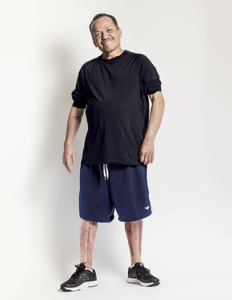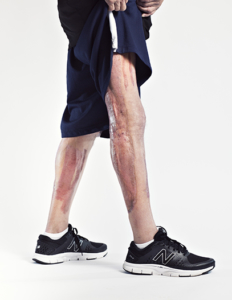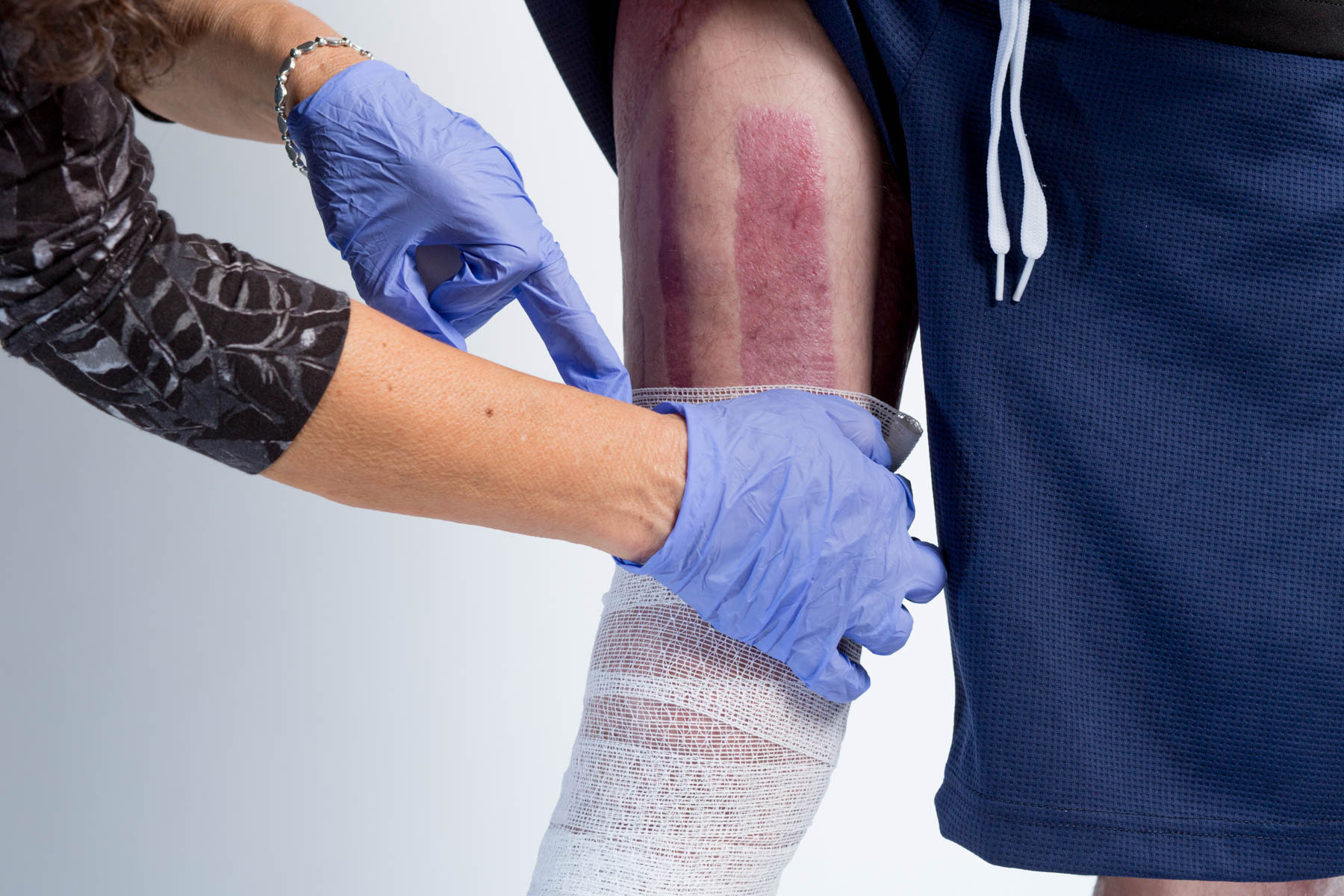
Alfred Lopez was treated at Keck Medicine of USC in May 2016 for a rare bacterial infection that rapidly eats away muscle and flesh. (Photo/Christina Gandolfo)
After being resuscitated in a USC Verdugo Hills Hospital operating room, Alfred Lopez was transferred to Keck Medical Center of USC on May 12, on a ventilator, in septic shock and experiencing multi-organ failure.
Lopez, a 56-year-old Ralph’s market produce worker, had necrotizing fasciitis, a rare bacterial infection that usually enters the body through an open wound and rapidly spreads through soft tissue, eating away at muscle and flesh at an alarming rate of an inch an hour.
In Lopez’s case, there was no trace of an open wound. Without being able to locate the origin of the flesh-eating disease in his body, the Keck Medical Center team raced against the clock to save his right leg — which had tripled in size — and his life.
“When they told me what it was, I knew we had a long battle,” said his sister Aurora Jubile, who had encountered the disease during her 31 years of experience as a registered nurse.
A CT scan finally pinpointed the disease’s source: A plum-sized abscess had ruptured in Lopez’s rectum and had spread into the soft tissues of his right leg.
“I was scared, but I had a lot of faith,” said Lopez, who has trouble remembering the early details of his ordeal because of the heavy sedation and pain he was in.
Lopez finally started turning a corner, thanks to the aggressive and unified approach taken by Keck Medical Center’s experienced surgeons, nurses and wound care physical therapists.
“Alfred survived with excellent functional results because of the state-of-the-art multidisciplinary team effort” available at Keck Medical Center, said Demetrios Demetriades, MD, PhD, director of the trauma and surgical intensive care unit division at the hospital and professor of surgery at the Keck School of Medicine of USC.
Demetriades performed seven of the 10 surgeries Lopez received during a three-and-a-half-month period.
To stay ahead of the bacteria, a team of six wound care physical therapists dressed his wounds every day, which sometimes took up to two hours to complete.
“The main challenge was the location and extent of his wounds, in particular his posterior hip and perineum,” said Angela Kwan, PT, MPT, lead in-patient wound care physical therapist at Keck Hospital of USC and instructor of clinical physical therapy at the USC Division of Biokinesiology and Physical Therapy.
Jubile had never seen anything like it. “His whole leg was without flesh. It looked like something out of an anatomy book.”
The fact that Lopez healed and wakes up every morning to walk a mile uphill (with the help of a cane) is nothing short of a miracle.
Stephanie Woelfel, PT, MPT, instructor of clinical physical therapy at the USC Division of Biokinesiology and Physical Therapy and a board-certified wound specialist, credits Lopez’s unlikely recovery to Demetriades’ high skill and the Keck Medicine team’s approach to complex cases.
“The collaboration in Al’s case is what made it so successful,” Woelfel said. “Dr. Demetriades would sometimes bring us (Kwan and Woelfel) into the operation room so that we could see what he was doing during surgery so that we knew what we were going to have deal with.”
Woelfel fell in love with wound care after graduating from Marquette University’s physical therapy master’s program.
“You can literally see the change happen in front of your eyes, week to week,” Woelfel said. “It’s awesome to see a wound heal like that.”

Alfred Lopez’s medical team at Keck Medicine of USC raced against the clock to save his right leg, which had tripled in size from the effects of necrotizing fasciitis. (Photo/Christina Gandolfo)
Wound care physical therapy can be traced back to World War II when physical therapists played an essential role in the rehabilitation and wound management of injured soldiers in acute care hospitals.
Since then, the specialized practice has evolved beyond wound dressing. Wound care physical therapists can provide patients electrostimulation, low frequency ultrasound and the application of negative pressure to promote wound healing.
“Wound care physical therapists provide a unique perspective because we look at the functional implications of a wound,” Woelfel said. This allows them to make recommendations to surgeons. “We think, ‘How is this going to affect the patient’s ability to move?’”
While Lopez was receiving antibiotics intravenously, the wound care team also inserted catheters into his dressings so that nurses could administer antimicrobial solution throughout the day, creating a two-pronged approach to treating the infection.
In addition to providing wound management to inpatients and outpatients at Keck Medical Center, Woelfel is one of the center coordinators for clinical education of physical therapy students. The physical therapy faculty practice at Keck Medicine of USC accepts more than 50 students a year for clinical training.
What makes USC’s physical therapy program different, Woelfel said, is that the students see the methods they are taught in the classroom directly reflected in the clinic.
The division’s integrated curriculum also affords students a well-rounded education by introducing them to various physical therapy specialties, such as wound care.
“It solidifies things,” Woelfel said. “Some students might ask, ‘Why do I have to learn about wound care?” Regardless of the area of physical therapy you practice in, all of your patients will have skin.”
Lopez, whose ordeal had turned him into a legend in Keck Medical Center’s hallways long before his Aug. 29 release, is especially grateful to Demetriades and the wound care physical therapists who still text him to see how he is doing.
“They are great people,” said Lopez, who is currently receiving physical and occupational therapy at Casa Colina. “They were all good to me, especially Stephanie and Angela. They were there all the time.”
— Stephanie Corral


